| Designation: | Type 69 |
 |
|---|---|---|
| Manufacturer: | NORINCO - China North Industries Group Corporation - CNGC | |
| Product type: | Armoured Vehicles | |
| Name: | Main battle tank |
PLA designation: Type 69, the Type 69-III is also known as Type 79
Manufacturer Designation: WZ-121
CONTRACTOR: 617 Factory (Baotou, Inner Mongolia); China North Industries Group Corporation (NORINCO)
SERVICE STATUS: The production stopped in the 1980s, with around 3,000 Type 69s and 1,000 Type 79s in service with the PLA ground forces.
The Type 69 is China's first attempt to design a main battle tank (MBT) independently. It is generally regarded as a modest upgraded version of the Type 59/T-54 MBT, with limited number of improvements. The design proposal was issued in 1963, and the initial design completed in 1964. The first Type 69 prototypes were built in 1964. In 1974 the tank received its approval certificate, and the batch production began thereafter, with several hundred tanks exported to the Middle East.
However, the 100 mm smoothbore gun used by the Type 69 was later proven to be an unsuccessful design. This resulted in a major redesign on the tank's weapon system. The improved variant Type 69-II with a 100 mm rifled gun was introduced in the early 1980s. This has become the most common member of the Type 69 family, with over four thousand tanks delivered to both the PLA and foreign customers.
Later a further modified variant Type 69-III (also known as Type 79) was introduced, integrated with the British Marconi fire control system and a Type 83 105 mm rifled gun with a replaceable thermal sleeve. It is the last member of China's first generation MBT with nearly 1,000 tanks delivered to the PLA.
Type 69: The Type 69 was based on the Type 59, with a 580 hp new engine and a 100 mm smoothbore gun. The 100 mm gun design was later proven to be unsuccessful. The Type 69 is also fitted with active infrared night vision and a laser rangefinder.
Type 69-I: Improved model fitted an IR searchlight modeled on soviet Luna system and collective NBC defensive system added.
Type 69-II: This is the most common version of the Type 69 family. The Type 69-II is equipped with the a 100 mm rifled gun derived from the 100 mm gun of the Type 59. This tank incorporates a new fire control system, which includes the TSFC 2-axis gun stabilization, a new Type 70 gunner's sight, laser rangefinder, and ballistic computer.
The Type 69-II can be distinguished from the earlier Type 59 by the rear engine plate that has a small elliptical bulge for the cooling fan. This version also has the driver's headlights mounted in two pairs on the fenders, not on the hull glacis. Some of these tanks were also outfitted with "Boom Shield" stand-off armor baskets on the turret.
Type 69-IIB/C: These are command versions of the Type 69-II equipped with additional command radio and long radio aerial. They can also be identified by the presence of a long tube welded to the turret top for the radio aerial and two stowage boxes on the hull rear, one of which contains cabling and a field phone.
Type 69-III (Type 79): The Type 69-III (WZ-121D) represents another enhancement of the Type 69. Most noticeable is the upgraded Type 83-1 105 mm rifled gun fitted with a replaceable thermal sleeve. This gun is similar to the 105 mm gun on the Type 88A MBT.
The Type 79 is also fitted with an improved fire-control featuring British Marconi technologies. Also missing are the IR searchlights which have been replaced by passive IR sights (later versions with thermal image). The tracks are fitted with removable rubber shoes. In PLA service this tank is known as the Type 79.
The Type 69 is similar to the Type 59 in appearance and general performance. Cast turret with conventional four-crewmember hull layout. Five large road wheels on each side. It is a relatively inexpensive and easy to operate tank but it is of an outdated design by modern standards. The interior is cramped and can be difficult to operate in.
The early version of the Type 69 is fitted with a Type 69 100 mm smoothbore gun. The gun could carry 44 rounds, with a maximum fire range of 1,000 m. Ammunitions include high explosive, high explosive fragmentation, and armour piercing discarding sabot. The gun was proven to be unsuccessful and was replaced by the 105 mm rifled gun on later variants.
The Type 69-II is fitted with a Type 69-II 105 mm rifled gun, with a simplified fire-control/night observation equipment.
The Type 69-III/79 is fitted with a modified Type 83-I 105 mm rifled gun. The gun is derived from the L7/Type-81 and capable of firing APFSDS, HEAT, and HEAT-FRAG.
Auxiliary weapons include one 7.62 mm coaxial machine gun and a 12.7 mm anti-aircraft machine gun mounted on the command cupola.
The Type 69-II's fire control system includes a TLRLA laser rangefinder, BCLA ballistic computer, TGSA gunner sight, and dual way stabilisation.
Wheels and tracks are protected by rubber hull skirts. The armour protection of the turret and hull has been proven to be inadequate during the 1991 Gulf War, as the Allies 120 mm tank gun can easily penetrate its front armour. No smoke grenade launcher fitted. Smoke can be generated by injecting diesel fuel in to the engine's exhaust.
The Type 69's combat weight is 36.5 tons (Type 79 is 37.5 tons). Early variants is powered by a liquid cooled, turbocharged 580 hp diesel, while Type 79 is powered by a liquid cooled 730 hp 12150L-7BW diesel engine.
|
||||||||||||||||||||||||||||||||||||||||||||||||
|
|||||||||
|
|||||||||||||||||||||||||||||||||
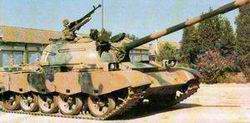 |
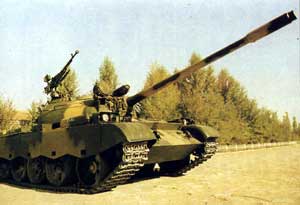 |
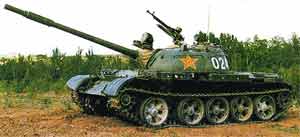 |
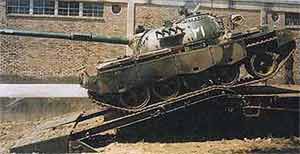 |
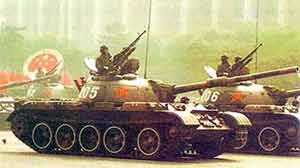 |
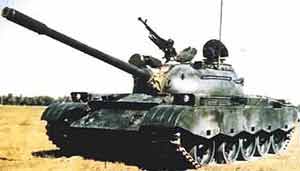 |
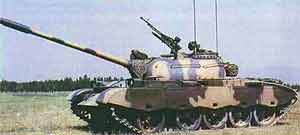 |
 |
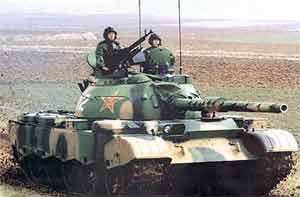 |








